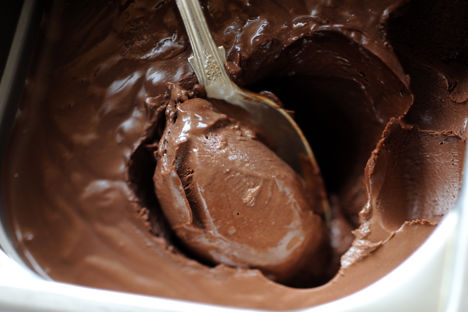
The origins of chocolate
Almost everyone loves chocolate. The next time you bite into your favourite bar, or melt some for a recipe, have a thought for the origins of this treat. Jonathan explores the fascinating history of chocolate.
The origins of chocolate
Almost everyone loves chocolate. The next time you bite into your favourite bar, or melt some for a recipe, have a thought for the origins of this treat. Jonathan explores the fascinating history of chocolate.
Mmm, chocolate, the 'food of the gods'. Dark, creamy, silken, melting, we associate it with hedonistic, sinful indulgence and enjoyment. But while the route of chocolate from Mesoamerica to modern global consumption is fairly straightforward and well understood, the production of chocolate is so complex and delicate that it is amazing we eat it at all.
Chocolate is the eventual product of the tree called Theobroma cacao, native to a range roughly from Mexico to Venezuela and the upper Amazon. Christopher Columbus, on his fourth trip to the Americas, was the first European to encounter and record evidence of cocoa – as a currency of exchange among native people. He and his crew also tasted the native cocoa drink, but they disliked it and paid it no more attention.
Cocoa remained something of a curiosity until Cortés invaded Aztec Mexico, though the native drink was still distasteful to the Spaniards, at first. Quickly, though, the conquistadors developed a taste for it, as the longer they remained in the Americas, the more Aztec foods they came to eat.
The Aztec drink was water-based, coarse, bitter, and spicy, with chillis, pepper, annatto seeds (for red color), and cornmeal. The Spanish introduced sugar and mixed in larger amounts of cinnamon and vanilla, gradually leaving out other spices. It was this modified preparation, sweeter and lightly spiced, that was introduced into the Spanish court in the 16th century and gradually conquered the European palate.
Too much chocolate is not just a modern peccadillo. Even by 1590, a scant 70 years after Cortés, Father Acosta wrote with some admonishment that Spaniards living in Mexico consumed huge amounts of cocoa drinks. Similar habits of conspicuous chocolate consumption became common in the courts of Europe over the following two centuries, reminiscent of Montezuma’s own legendarily massive cocoa diet.
The Portuguese transplanted cocoa to São Tome and West Africa, the Dutch to East Africa and Indonesia, the British to India and Sri Lanka, and the Spanish to the Philippines. Much of the cultivation was by forced labour, which remains a problem that Fair Trade and other equality movements are attempting to reduce. But cocoa is a notoriously challenging crop.
The cocoa tree is delicate and requires both humidity and shading. It only grows in the tropics. The highly perishable pods must be harvested and seeded by hand, the seeds then fermented in large batches, and carefully dried. These seeds must then be roasted twice, once to remove the fibrous coating and once more to develop flavour. The roasted seeds then must be ground into a liquid called 'cocoa liquor', in which particles of cocoa about the same size as red blood cells are suspended in cocoa butter. Without proper roasting and grinding, chocolate basically resembles mud.
Into the 1950s, the science of chocolate was poorly understood. Industrialised manufacture was little more than a scaling up of the Aztec process. We now know that a remarkable set of linked, cascading microbial, biological, chemical, and physical transformations are required to go from pod to bar.
The primary chocolate market developed in Europe, and industrial manufacture began in England in the late 1700s. Cocoa cultivation has remained separated from processing and consumption due to both colonial legacy and a practical factor: the milling and finishing of solid chocolate works best in cool, dry conditions. So entrenched is the industrial and socioeconomic division that some chocolate makers have remarked with regret that their cocoa growers have never eaten a chocolate bar.
Chocolate flavour depends on the entire process: the variety of cocoa, the terroir of its growth and fermentation, and its roasting and processing. There are three general varieties of cocoa now grown worldwide. Criollo, originally from Central America, is the most prized and best flavoured, but the most delicate. Forastero, originally Amazonian, is the most robust, hardy, and productive, now accounting for 85% of global cultivation. And trinitario seems to be a hybrid with much variety, originally found on Trinidad.
I haven't even begun to touch on the range of uses or recipes for chocolate. Remarkably, purified cocoa butter, not chocolate, is the most valuable cocoa product, worth so much to the cosmetic and pharmaceutical industries (uses dating to 1700) that the chocolate we eat often contains soya lecithin as a substitute emulsifier. In fact, the percentages listed on chocolate bars refer to the 'cocoa mass' – the solids, not the butter – used in that particular recipe. White chocolate has had all of the cocoa mass removed, but is an old medicinal concept. Milk chocolate is a relatively new invention, made using milk powder.
It may seem that chocolate grows increasingly complicated, described like wine and just as intricate. But don’t let that stop you going out and eating a lot of it to find what you like best. My favourite is 74% dark Madagascar. What’s yours?
– ACOSTA, J. D., GRIMESTON, E. & MARKHAM, C. R. (1880). The natural & moral history of the Indies. Original Spanish 1590, Original English Translation 1604. London: Printed for the Hakluyt Society.
– BROOKES, R. tr. (1730). The natural history of chocolate. Original French, D. de Chelús, 1719. London: J. Roberts.
– COE, S. D. & COE, M. D. (1996). The true history of chocolate. New York, Thames and Hudson.
– HARDY-GOULD, J. (2011). Chocolate. Oxford: Oxford University Press.
– KNAPP, A. W. (1920). Cocoa and chocolate, their history from plantation to consumer.
– MOSS, S. & BADENOCH, A. (2009). Chocolate: a global history. London: Reaktion Books.
Online resources:


